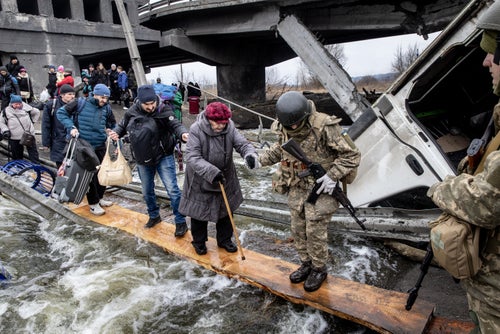

Russia has announced new “humanitarian corridors” to provide safe passage for Ukrainian civilians fleeing the invasion instigated by Vladimir Putin.
But the limited ceasefire was dismissed by Ukraine and Western allies as an immoral stunt, as the escape routes would only take displaced people to Russia and its ally Belarus.
What are humanitarian corridors?
A humanitarian corridor is a temporary pause of armed conflict, agreed by both sides, to allow food and medical aid to be brought to a warzone, or for civilians to evacuate.
These demilitarised zones are in most cases negotiated by the United Nations, and are seen as vital to avoiding a humanitarian catastrophe, especially when international law is breached by the shelling of civilians.
Humanitarian corridors have been used since the mid-20th century. During the so-called Kindertransport from 1938 to 1939, Jewish children were evacuated to the UK from areas under Nazi control. They were also created during the siege of Sarajevo, Bosnia, in the 1990s and the 2018 evacuation of Ghouta, Syria.
Access is typically limited to neutral parties, such as the UN or aid organisations including the Red Cross.
What has been proposed?
The Russian invasion has pushed 1.5 million people to flee the country, creating what the head of the UN refugee agency called “the fastest-growing refugee crisis in Europe since World War II”.
Two planned evacuation operations from Mariupol and the nearby city of Volnovakha have failed over the last two days as the sides accused each other of failing to stop shooting and shelling.
In Mariupol alone, Ukrainian authorities have said they planned to evacuate over 200,000 civilians, or half of the city’s population.
Ahead of a third round of talks between Russia and Ukraine planned for Monday, Moscow said it would open six humanitarian corridors – passages would open for civilians from the capital of Kyiv, the southern port city of Mariupol, and the cities of Kharkiv and Sumy.
But Ukraine rejected the plan given the proposed routes led into Russian or Belarusian territory. These are unlikely destinations for many Ukrainians who would prefer to head towards countries on the western and southern borders. Belarus is a key ally of Putin and served as a launching ground for the invasion.
According to maps published by the RIA news agency, the corridor from Kyiv will lead to Belarus, and civilians from Kharkiv will only have a corridor leading to Russia. Corridors from Mariupol and Sumy will lead both to other Ukrainian cities and to Russia.
What has Russia said?
The Russian taskforce said the new pledge for humanitarian corridors was announced at the request of French president Emmanuel Macron, who spoke to Putin on Sunday. Macron’s office said he asked for a broader end to military operations in Ukraine and protections for civilians.
“Attempts by the Ukrainian side to deceive Russia and the whole civilised world...are useless this time,” the Russian defence ministry said after announcing the corridors.
What has Ukraine said?
Ukrainian deputy prime minister Irina Vereshchuk called the proposed evacuation routes to Russia and Belarus “unacceptable”. “Our people won’t go to Belarus and to Russia,” she told a news briefing, claiming that Russia was seeking to manipulate Macron’s sincere desire to help.
Macron criticised the proposal as a case of “cynicism”. “I don’t know many Ukrainians who want to seek refuge in Russia. That’s hypocrisy,” he said.
A spokesperson for Ukrainian president Volodymyr Zelenskyy said the Russian proposal was “completely immoral”. “They are citizens of Ukraine, they should have the right to evacuate to the territory of Ukraine,” the spokesperson said.
The Ukrainian government is proposing eight humanitarian corridors, including from Mariupol, that would allow civilians to travel to the western regions of Ukraine where there is no Russian shelling.
The Russian proposal was reminiscent of similar ones in Syria. In 2016, a joint Russian and Syrian proposal to set up humanitarian corridors out of besieged opposition-held eastern Aleppo was criticised on humanitarian grounds.
Human rights activists said the tactic, coupled by brutal sieges, effectively gave residents a choice between fleeing into the arms of their attackers or dying under bombardment.